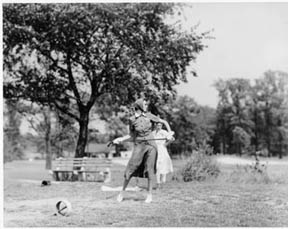Jamaica Bay and the Rockaways
The Daily Plant : Tuesday, April 15, 2003
MeMorabiliA QNS

Lately it seems every conversation about art in New York City requires at least some mention of Queens. The city’s largest borough (and second most populous) offers world famous shows such as the Matisse-Picasso exhibit at MoMA QNS, as well as showcases for emerging artists at P.S.1 and SculptureCenter. Indeed, this borough has experienced a renaissance in the beaux-arts and established itself as a destination for visitors from around the world. But your visit to Queens should not end at MoMA QNS or P.S. 1. Instead, the perfect next stop on the art train should be the Queens Historical Society, where Queens Jewels: A History of Queens Parks is now on display through September 21, 2003.
Parkies may remember that this exhibit was shown last year at the Arsenal Gallery, Central Park’s premiere venue for art. Indeed, much like the caravans that transported works of art from Manhattan to Long Island City during MoMA’s temporary move, these photographs, historic postcards and memorabilia have been transported across the East River for Queens residents and visitors to enjoy. Jonathan Kuhn, curator of the exhibit and Parks & Recreation’s Director of Art & Antiquities, worked closely with the Queens Historical Society while preparing the exhibit originally and the move came naturally.
"I learned about the exhibit before it opened at the Arsenal, and a bell went off that it was something we wanted to have here," said the Society’s director, Mitchell Grubler. "We are delighted to have this exhibition in Queens where we expect many of our borough’s residents will come to see this celebration of our numerous and varied parks."
The vintage photographic images include early street tree care in Flushing, a lumber camp in Forest Park, the first Queens playground, Ashmead, and floral displays in Long Island City. The era of Parks Commissioner Robert Moses (1934-1960) is well represented with images of smiling children at new WPA playgrounds, the spectacular Astoria Park Pool, Rockaway Beach and boardwalk, and the transformation of Flushing Meadows Corona Park into the borough’s premier park, which hosted two World’s Fairs and the United Nations. Striking views of forests and wetlands, then and now, highlight the many natural sanctuaries of Queens. The exhibition also includes a 1940 bronze sculpture bust of Walter Cunningham, for whom Cunningham Park is named.
"Many Queens residents will find images that recall their youth, but the exhibition is not about nostalgia," said Jonathan Kuhn. "Rather, it is about the continuity between the history of these parks and their ongoing vitality."
A century ago Queens did not have a park system, only a scattering of town greens and squares, and its largest park was known misleadingly as the Brooklyn Forest. From the prime Atlantic beachfront of Rockaway to playgrounds, recreation centers, pools, golf courses, natural wetlands, historic houses and monuments, this exhibition examines the diversity of Queens parks.
The photographs are from the New York City Photo Archive and Parks & Recreation collections, and there are postcards on loan from the Queens Borough Public Library, Long Island Division. The exhibition is curated by Jonathan Kuhn and the program is supported, in part, by public funds from the New York City Department of Cultural Affairs, and by the City Parks Foundation/Mellon Foundation Grant Program.
Kingsland Homestead is open to the public Tuesday, Saturday and Sunday from 2:30 p.m. to 4:30 p.m., or by appointment. It is located at 143-35 37th Avenue in Flushing, Queens. For more information call (718) 939-0647. Admission is $3 for adults, $2 for students and seniors.
QUOTATION FOR THE DAY
"We work in the dark—we do what we can—we give what we have.
Our doubt is our passion, and our passion is our task.
The rest is the madness of art."
Henry James
(April 15, 1843-1916)
Check out your park's Vital Signs
Clean & Safe
Green & Resilient
Empowered & Engaged Users
Share your feedback or learn more about how this park is part of a
Vital Park System

Know Before You Go
Ecology Park is only open at certain times of year when Parks staff are present in order to protect this unique landscape. Want to visit? Check out our Stewardship Projects page for restoration, planting, and educational events.



